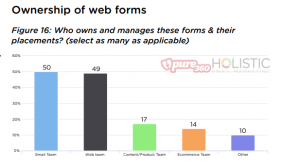The Ownership of Web Forms Within Websites Remains a Well-Acknowledged, yet Unsolved Issue Within Most Organizations, Finds a New Report on Email Marketing
Intelligent personalization rules the roost in marketing automation campaigns, especially when you are dealing with emails. The email-blast era is nearing its logical end. To take its place, email marketers are exploring and adopting new-age personalization technologies with data-driven email marketing strategies. Web forms, most marketing teams would agree, are key to driving personalization across websites, emails, e-commerce, and now, even social media. Web forms drive maximum database signups; yet, it’s actually 50-50 between website and email marketing team when it comes to web form ownership, and hence, the subsequent personalization campaigns.

According to a new report by Holistic Email Marketing in partnership with marketing-technology provider Pure360, 24% of email teams solely owned the web forms and 24% of web teams solely owned the web forms. That’s a catch-22 situation for businesses that are aggressively looking to amplify their email personalization efforts.
Recommended Read: Influencer Solutions Will Become a Core Component of the Marketing Stack
46% percent of the respondents see personalization as a priority in their email marketing program. In the report titled, “Email Marketing Personalization“, another 16% of the respondents agree that email personalization is a ‘nice-to-have’ addition to their existing email marketing strategies.
“94% of brands are, to varying degrees, personalizing their messages to their customers and subscribers.” – Email Marketing Personalization Report
The latest email marketing report also studies the number and kinds of data they use and the challenges that prevent email teams, even those with 20+ members, from expanding personalization.
Key Takeaways from the Report
Personalization Is Becoming the Norm for Most Marketers.
Only 18% of marketers said they aren’t actively personalizing – some just haven’t gotten started while a tiny percentage choose not to use it.
Nearly All Marketers Have the Tools for Personalization.
Six percent of marketers said they can do no personalization using their email platforms. Almost half (49%) have access to tools for basic personalization, while 36% are using advanced tactics such as dynamic content. Another 8% are leading the way with AI, machine learning, and other technology.
Read more: The Art and Science of Retargeting for Marketers in 2018
Many Email Marketers Don’t Own the Web Forms They Need to Succeed with Personalization.
Although 72% of marketers get most of their data from web forms, 24% said the web team wholly owns those forms. That means this 24% of email marketers can’t control the design and placement of those forms in order to gather both, permission as well as valuable data.
Marketers Are Moving Beyond Personalizing Only the Subject Line or First Name.
Marketers are incorporating data from email behavior (56%), purchase history (41%), lifecycle stage (29%) and even contextual data (12%) to add relevant content meaningful to individual recipients.
Marketers Who Test Their Personalization Efforts Rely More on Campaign Metrics Than Customer Metrics.
Conversions opens, and clicks are the top-3 metrics marketers use to measure the effectiveness of their personalization efforts. A fewer use potentially more meaningful metrics, such as customer lifetime value or average order value, which measure performance on business goals.
Email Personalization: No Longer a ‘Nice to Have’
“Now that automation and data tools are standard offerings on even mid-level email platforms, we wanted to learn how marketers are using them to personalize and enhance their messaging,” says Kath Pay, Founder and CEO of Holistic Email Marketing and author of the report.
Kath added, “Some marketers have mastered the art and science of personalization, using advanced data collection to personalize every aspect of the email journey. Others are testing the waters using basic segmentation on key aspects of their messages. But we were surprised to find marketers of large corporations, with large teams, stating their main challenge was lack of resources.”
“It’s encouraging to see personalization is a top priority for nearly 50% of respondents with another 35% looking to implement soon,” says Komal Helyer, Marketing Director for Pure360.
Komal added, “As consumers, we’ve been long exposed to personalization from brands such as Amazon, Netflix, and Spotify. These brands realized the power of personalization early on and were quick to develop their experience around it.”
Read More: Interview with Jon Lombardo, Global Brand Strategy Lead, LinkedIn
Email Marketing: The Unconquered Territory for Personalization
Personalization within emails remains an unconquered territory for most businesses, largely because of the lack of clarity in what to personalize and what to exclude. Majority of email marketers focus on not more than three elements or types of content in their personalization. We feel, it’s a shame to not include more elements, especially when you would agree that personalization is a great “lens” to amplify brand-audience messaging, catering to exact needs based on data and shopping analytics. Of course, testing and attribution to email personalization remain a challenge from the different orbit, and we would wait for the marketers to speak more about it.
Recommended Read: Salesforce Einstein Analytics Unveils Conversational Queries to Simplify Data



